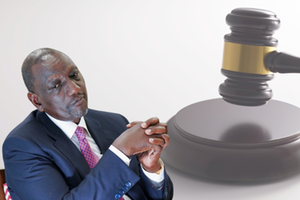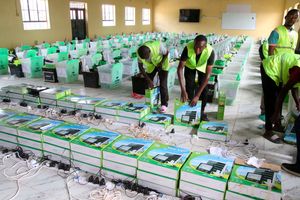
Deputy President William Ruto (left) shakes hands with ODM leader Raila Odinga during the Mashujaa Day celebrations at Wang’uru Stadium in Kirinyaga County on October 20, 2021.
News
Premium
How new voter listing will reshape race to succeed Uhuru
What you need to know:
- The new figures have identified areas that are likely to supply swing votes.
- Ruto and Raila have decided to split the country into regions to shore up their chances of winning.
The electoral agency has reported new voter registration numbers, which could reveal patterns that political parties will seek to exploit in the 2022 State House race and other contests.
In the October voter registration drive, the Independent Electoral and Boundaries Commission (IEBC) enrolled 1,519,294 new voters, pushing the number of Kenyans eligible to vote in 2022 to just over 21 million, up from 19.6 million in 2017.
“The commission will subject the said 1,519,294 new voters’ record to a deduplication process that involves comparing the biometric data of the new voters with those of the existing 19,668,968 voters for the purpose of eliminating any multiple records,” said IEBC chairman Wafula Chebukati in a statement.
“In addition, the commission will service the requests for transfer, change of particulars and deletion of dead voters from the Register of Voters.”
For presidential candidates, however, the greater interest is in the voter registration patterns, often used to forecast outcomes with reasonable accuracy, given Kenyans’ inclination to vote as regional blocs.
So important are these numbers that Deputy President William Ruto and his political nemesis, ODM boss Raila Odinga — both seen as frontrunners in the 2022 State House contest — have decided to split the country into regions to shore up their chances of winning.
Even though IEBC did not reach its six million target, the new vote listing has revealed Rift Valley (5.09 million), Central (3.04 million), Nyanza (2.9 million), Nairobi (3.08) and Western (2.08) as the richest hunting grounds that politicians are likely to focus on.
In the rest of the country, Coast listed 1.85 million, North Eastern 572,116, Upper Eastern 1.54 million and Lower Eastern 1.6 million new voters.
But because presidential candidates are required to garner 50 per cent of votes plus one and 25 per cent in at least 24 counties to be declared winner, even counties that listed fewer voters will still be courted.
At 2.4 million, Nairobi leads with the highest number of voters eligible for the 2022 race, followed by Kiambu (1.24 million), Nakuru (1.01 million), Kakamega (801,552), Meru (750,335), Machakos (659,829), Mombasa (621,791), Bungoma (611,054), Murang’a (610,336) and Kisii (603,512).
In past elections, some of these areas were largely behind Mr Odinga, but a spirited campaign by the ruling Jubilee Party before the 2017 General Election not only increased its numbers in the regions but also showed that they were potential battle zones with the right campaign messaging.
In 2017, Mr Odinga garnered 801,031 votes against President Uhuru Kenyatta’s 287,606 in the six coastal counties. The region has now registered 140,913 new voters, raising its numbers to 1.85 million from 1.7 million in 2017.
The former Prime Minister received 299,380 votes from the three Maa counties of Narok, Kajiado and Samburu against 367,603 for Mr Kenyatta. They are now swing votes that could determine the outcome of next year’s poll.
Political analysts, however, warn that there might be a low turnout in 2022 and presidential hopefuls should woo younger voters especially.
With high voter apathy among the youth, who were the main target in the recent voter registration drive, political experts argue that the younger generation might not be the ones who determine who succeeds President Kenyatta.
“From the latest figures from IEBC, it is clear now that the youth will, after all, not be the main determinants of the winner come next year,” said Prof Egara Kabaji of Masinde Muliro University.
The figures, he said, have given the contenders a clear picture of where to camp in their vote-hunting campaigns.
“Those who are in the race to succeed President Kenyatta are now going to strategise with real figures and not the imaginary numbers which they have been using,” Prof Kabaji said.
Cognisant of the role younger people are likely to play next year, DP Ruto continues to portray himself as the only candidate who understands their needs.
“The present and future of this country belongs to the youth. It is they who are bearing the heaviest burden of economic challenges and should therefore vote wisely in the next election - for a President whose agenda is economic reforms,” he told a rally in Kitui recently.
His message to young Kenyans is that his competitors belong to a Kenya of the past.
He said his opponents had failed to offer an alternative to his bottom-up economic development model that seeks to uplift those at the base of the wealth pyramid.
The new figures have identified areas that are likely to supply swing votes, with DP Ruto and Mr Odinga having embarked on aggressive campaigns in key political battlegrounds.
DP Ruto’s camp is banking on his bottom-up economic model to win the hearts of many Kenyans struggling in a sluggish economy.
“The United Democratic Alliance’s (UDA) bottom-up economic model and strategy and the soon to be launched manifesto provide an optimistic proposal (for tackling) the current socio-economic problems and challenges of hustling Kenyans,” Turkana Governor Josphat Nanok told the Nation yesterday.
“Small and medium businesses, mama mboya’s, boda boda operators, starter entrepreneurs, unemployed skilled and unskilled youths, etc. UDA gives Kenyans and voters something promising to look forward to and this will mobilise voters (young and old, existing voters and new ones) to participate in the election.”
And President Kenyatta’s restive political backyard of Mt Kenya, slowly taking shape as the country’s biggest swing vote in 2022 - especially Kiambu, Laikipia, Nyeri, Kirinyaga, Nyandarua counties - has added 3.05 million votes while Mt Kenya east gained a paltry 77,551.
Both DP Ruto and Mr Odinga have promised to address the plight of the region’s farmers by prioritising value addition to improve earnings from their harvests, and protect businesses with lower taxes and cheaper loans.
Voter apathy should worry presidential hopefuls, said political commentator and governance expert Javas Bigambo. If they do not come up with an agenda that inspires people to vote, he said, garnering the constitutional threshold of 50 plus one might be difficult to achieve.
“The failure of IEBC to achieve even 50 percent of projected new voters shows that actual political participation in the 2022 General Election may be lower than hoped for,” he said.
“Various regions, for instance, Western, Central, could be some of the areas that may not register impressive voter turnout.”
The new figures, said Prof Ken Oluoch, head of the political science department at Moi University, will have little impact on the State House race.
“I don't think the new IEBC figures may be significant in any way. First of all, they are way below the expected figures. Secondly, there is no major increase in numbers in any region to give any presidential candidate any advantage,” Prof Oluoch argued.
The voter listing is so integral that Mr Odinga wants IEBC to roll out another drive in early 2022 before the August polls.
“In February and March 2022, IEBC should register voters again so that no one is left out of participating in the 2022 General Election,” Mr Odinga said recently.
Those sentiments were echoed by UDA secretary-general Veronica Maina.
“If there are less than a million voters registered so far, then it means that the exercise has not reached its expected target. IEBC needs to think on how to deal with this scenario to reach its target,” Ms Maina told the Nation.
In an interview with Musyi FM yesterday, Mr Odinga expressed optimism that his Azimio la Umoja (quest for unity) has been well received. He plans to tour Wiper leader Kalonzo Musyoka’s political bedrock of Ukambani this morning.





